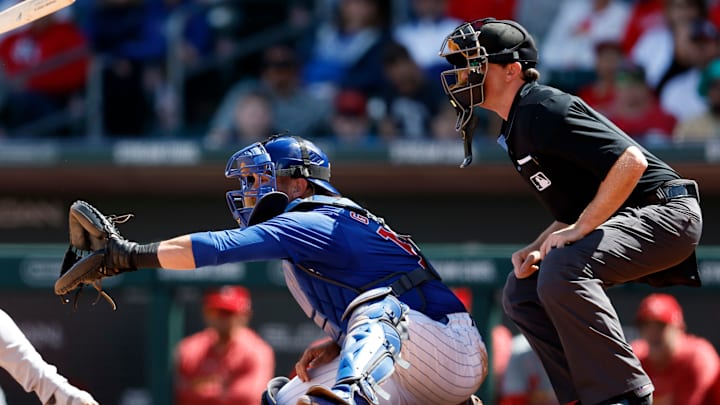Thursday's Cactus League game between the Los Angeles Dodgers and Chicago Cubs will be more than just the first spring training game of 2025. It'll also be a bit of baseball history: For the first time since MLB first began testing the technology in independent ball more than half a decade ago, robo-umps will be in use for a big-league contest.
Okay, so maybe "robo-umps" is a little bit too science-fiction. The actual term is automated ball-strike technology, or ABS for short, and it's less a replacement for home-plate umpires than it is an insurance policy. But no matter what you call it, it represents a sea change in how baseball is played at the highest levels of the sport. Here's everything you need to know before it makes its Major League debut on Thursday afternoon.
For more news and rumors, check out MLB Insider Robert Murray’s work on The Baseball Insiders podcast, subscribe to The Moonshot, our weekly MLB newsletter, and join the discord to get the inside scoop during the MLB offseason.
Roboumps at spring training: How does MLB's ABS challenge system work?
For the baseball purists among you, allow us to reiterate: Yes, there will still be a home-plate umpire, and that home-plate umpire will still be calling balls and strikes using their own two eyes and their understanding of the strike zone. ABS is, instead, used as part of a challenge system, one that started in the independent Atlantic League (under MLB supervision) and has spent the last few years working its way up the Minor League system, including implementation at a handful of Triple-A ballparks last season.
Here's how that challenge system will work:
- After any pitch, a hitter, pitcher or catcher can challenge a ball or strike call. That challenge must come quickly — MLB offers a little wiggle room here, but within one or two seconds as a general guideline — or the home-plate umpire can decide to decline it. If the challenge is delivered in time, the umpire will stop play and wait for the call to be reviewed.
- During that review, a graphic will appear on the ballpark jumbotron and television screens at home, one that looks a bit like the Hawkeye displays used during tennis challenges. That graphic will reveal the flight of the pitch and whether it crossed the plate inside or outside of the official strike zone. If the call is overturned, the count will be corrected and play will promptly continue. If the call stands, the challenging team loses one of its two challenges for the game.
- While each team begins with two challenges, it can earn more if it uses those two wisely. While an incorrect challenges removes one of those two from use, teams get to keep their correct challenges, meaning that you can challenge as many calls as you'd like as long as you're right. Will managers be able to keep control over which and how often players issue challenges in the heat of the moment? Will players go rogue and waste a challenge again their coaching staff's wishes? We'll have to wait to find out.
- That all begs the question: How does the league determine what is and isn't a strike in the first place? Here's the wording in the official rulebook: “the area over home plate from the midpoint between a batter’s shoulders and the top of the uniform pants — when the batter is in his stance and prepared to swing at a pitched ball — and a point just below the kneecap.” In order to prevent batters from gaming the system, switching up their batting stances in order to create a smaller strike zone, MLB now defines the strike zone’s upper limit as 53.5 percent of a player’s total height, with the bottom at 27 percent. Yes, that means the league has gone from clubhouse to clubhouse this spring, getting standardized measurements of each player's height in order to calibrate their specific strike zone.
If this all sounds too hare-brained for you, take heart: None of this is set in stone just yet. This is just a trial run for the spring, after which the league will solicit feedback from teams to get a sense of what works and what doesn't. Then it'll implement that feedback for another year at Triple-A, with an eye toward bringing the ABS system to the Major League regular-season in 2026 or beyond.
2025 MLB All-Star Game uses ABS challenge system
Before MLB officially launches the ABS challenge system, they decided to use it during the 2025 All-Star Game. In fact, it was factored in relatively early.
In the bottom of the first inning, a pitch thrown by Tarik Skubal of the Detroit Tigers to San Diego Padres third baseman Manny Machado was called a ball. But the first ABS challenge review was called. After a few seconds, it was determined that the pitch thrown by Skubal was actually a strike, resulting in a Machado strikeout.
Our first ABS Challenge of the All-Star Game! pic.twitter.com/DIXRgra6fg
— FOX Sports: MLB (@MLBONFOX) July 16, 2025
The challenge system was viewed as a success by fans, as it didn't slow down the game, and it made sure that the right call was made. Now, fans wait to see when the ABS system will be included into regular season games. Maybe, just maybe, it will be included in the 2026 regular season.
